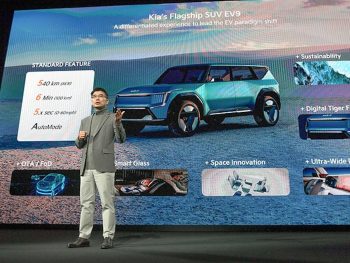Kia to launch 14 fully electric models by 2027
Kia has ramped up its plans for fully electric vehicles, targeting a 14-strong model line-up by 2027 that includes two electric pickup trucks and an entry-level model.

Kia will establish a line-up of 14 battery electric vehicles by 2027; previously it had targeted 11 BEV models by 2026
It’s part of the brand’s plans to sell 1.2 million electric vehicles globally in 2030, unveiled in its new 2030 roadmap at its 2022 CEO Investor Day virtual event.
Its ‘Plan S’ strategy launched two years ago laid down a target of 11 battery electric vehicles (BEVs) by 2026 but this is now being expanded as the carmaker looks to “solidify its position as the world’s leading EV maker”.
Alongside electrification, the brand has three other key business targets for 2030.These include reaching four million annual vehicle sales by 2030 – a 27% increase from the target for 2022 and including over two million “eco-friendly” models. It’s also looking to expand the application of connected car features and autonomous driving technologies to all new vehicles.
And Kia plans to become the number one brand in the global purpose-built vehicle (PBV) market by 2030.
EVs are central to its plans for achieving annual sales of four million units through “popularising eco-friendly” vehicles, which include BEVs, plug-in hybrid electric vehicles (PHEVs) and hybrid electric vehicles (HEVs).
These will be the focus of future business growth. Kia will expand the proportion of eco-friendly cars from 17% of global sales in 2022 to 52% in 2030.
In major markets with strong environmental regulations and a growing demand for EVs, such as Korea, North America, Europe and China, Kia plans to increase its proportion of eco-friendly car sales by up to 78% by 2030.
This will be supported by the expanded line-up; starting in 2023, Kia plans to launch at least two BEVs per year, including the two pickup trucks – which answer a core need for a large number of fleets looking to go electric – and a new entry-level model, potentially a replacement to the current Picanto.
Kia also said it would reaffirm its leadership in the EV market through its flagship electric vehicle, the EV9, set for launch in 2023. The fully electric large SUV will have a 0-100km/h time of five seconds, and range of approximately 540km (some 366 miles) on a full charge. It can also provide 100km driving range on just a six-minute charge.
The carmaker will also reinforce its EV plans under a regional production approach.
In Europe, for example, small and medium-sized EVs will be produced starting from 2025. In the US, where mid-sized SUVs and pickups are popular, electric versions of these models will be produced locally from 2024. In China, Kia plans to introduce mid-size electric vehicle models from next year and in India it plans to produce entry and mid-size EV models from 2025.
Plans also include a new battery supply and demand strategy, alongside upgraded battery technology, in response to a significant increase in demand due to the higher EV sales – it’s expecting demand to increase to 13GWh to 119GWh in 2030.
Batteries will come from an Indonesian battery cell joint venture and the brand will simultaneously establish a stable battery supply and demand system by outsourcing to global battery companies.
In addition, Kia plans to increase battery energy density by 50% by 2030 and cut system costs by 40%, driving both performance and price competitiveness.
Connected car and autonomous driving technology vital to strategy
Alongside EVs, connected car services and autonomous driving technology are also fundamental parts of the four-pronged strategy.
The EV9 arriving in 2023 will feature Kia’s first OTA (Over the Air) and FoD (Feature on Demand) services that will allow customers to selectively purchase software functions. And it will be the first model to come with Kia’s AutoMode autonomous driving technology.
From 2025, all new Kias will be come with connected car features, and OTA software updates and FoD services will be available across the Kia line-up; not only allowing customers to keep their vehicles up-to-date with various features and technologies, but also providing the carmaker with new business opportunities based on software and connected car services. This includes mobility areas such as car-sharing, car-hailing and delivery services; supporting Kia’s mobility-focused brand transformation.
Following its EV9 debut, the AutoMode range of autonomous driving technologies will be rapidly expanded throughout the line-up. This will be available with wireless updates and will include a Highway Driving Pilot feature, which would enable driving without driver intervention on highway sections.
By 2026, all new models launched in major markets will be available with AutoMode autonomous driving technology, with an adoption rate expected to surpass 80%. Long term, the company plans to further upgrade AutoMode technology and implement fully autonomous driving technology.
Plans for PBV leadership
Kia is also seeking to secure leadership in the global PBV market, highlighting that the demand for delivery and logistics services has increased significantly following the acceleration in e-commerce during the pandemic.
In the near term, Kia plans to develop PBV models derived from current models such as Niro Plus, due to be introduced later this year.
In the mid-to long term, it will develop dedicated PBVs; its first dedicated model is expected in 2025, timed to coincide with the maturing of the PBV market, and similar in size to a medium-sized vehicle, but with inherent scalability.












